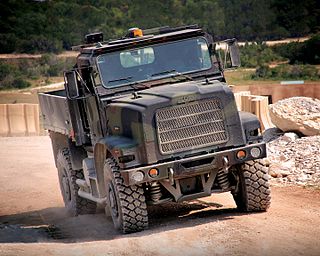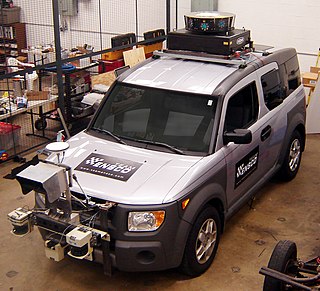Related Research Articles

A self-driving car, also known as an autonomous car, driver-less car, or robotic car (robo-car), is a car incorporating vehicular automation, that is, a ground vehicle that is capable of sensing its environment and moving safely with little or no human input.
The DARPA Grand Challenge is a prize competition for American autonomous vehicles, funded by the Defense Advanced Research Projects Agency, the most prominent research organization of the United States Department of Defense. Congress has authorized DARPA to award cash prizes to further DARPA's mission to sponsor revolutionary, high-payoff research that bridges the gap between fundamental discoveries and military use. The initial DARPA Grand Challenge was created to spur the development of technologies needed to create the first fully autonomous ground vehicles capable of completing a substantial off-road course within a limited time. The third event, the DARPA Urban Challenge extended the initial Challenge to autonomous operation in a mock urban environment. The most recent Challenge, the 2012 DARPA Robotics Challenge, focused on autonomous emergency-maintenance robots.

An unmanned ground vehicle (UGV) is a vehicle that operates while in contact with the ground and without an onboard human presence. UGVs can be used for many applications where it may be inconvenient, dangerous, or impossible to have a human operator present. Generally, the vehicle will have a set of sensors to observe the environment, and will either autonomously make decisions about its behavior or pass the information to a human operator at a different location who will control the vehicle through teleoperation.

Vehicular automation involves the use of mechatronics, artificial intelligence, and multi-agent systems to assist the operator of a vehicle. These features and the vehicles employing them may be labeled as intelligent or smart. A vehicle using automation for difficult tasks, especially navigation, to ease but not entirely replace human input, may be referred to as semi-autonomous, whereas a vehicle relying solely on automation is called robotic or autonomous. Both of these types are instantiated in today's various self-driving cars, advanced airliner autopilots, drone aircraft, and planetary rovers, as well as guided rockets and missiles. After the invention of the integrated circuit, the sophistication of automation technology increased. Manufacturers and researchers subsequently added a variety of automated functions to automobiles and other vehicles. The technology involved in implementing autonomous vehicles is very expansive, ranging from technological improvements in the vehicle itself to the environment and objects around the vehicle. As the use of automated vehicles increases, they are becoming more influential in human lives. Although automated vehicles bring various benefits, they also come with various concerns. Also, there are still technological challenges that need to be overcome in order to make vehicular automation robust and scalable.

TerraMax is the trademark for autonomous/unmanned ground vehicle technology developed by Oshkosh Defense. Primary military uses for the technology are seen as reconnaissance missions and freight transport in high-risk areas so freeing soldiers from possible attacks, ambushes or the threat of mines and IEDs. The technology could also be used in civilian settings, such as autonomous snow clearing at airports.

The VaMP driverless car was one of the first truly autonomous cars along with its twin vehicle, the VITA-2. They were able to drive in heavy traffic for long distances without human intervention, using computer vision to recognize rapidly moving obstacles such as other cars, and automatically avoid and pass them.

The third driverless car competition of the DARPA Grand Challenge, was commonly known as the DARPA Urban Challenge. It took place on November 3, 2007 at the site of the now-closed George Air Force Base, in Victorville, California, in the West of the United States. Discovery's Science channel followed a few of the teams and covered the Urban Challenge in its Robocars series.
There are a number of competitions and prizes to promote research in artificial intelligence.

The Personal Urban Mobility and Accessibility (PUMA) was an experimental electrically powered road vehicle created by Segway and adopted by General Motors as a concept vehicle representing the future of urban transportation. It operates on two wheels placed side by side, a layout that differs in placement from motorcycles which instead have their two wheels placed at the front and rear.
VisLab is an Italian company working on computer vision and environmental perception for vehicular applications. It was founded in the early 90s as a research laboratory at University of Parma. It started its activities in 1990, with its involvement within the Eureka PROMETHEUS Project. Since then the research group focused on vehicular applications.

Alberto Broggi is General Manager at VisLab srl and a professor of Computer Engineering at the University of Parma in Italy.

General Motors EN-V is a 2-seat urban electric concept car jointly developed by Segway Inc. and General Motors that can be driven normally or operated autonomously.

Waymo LLC is an American autonomous driving technology development company. It is a subsidiary of Alphabet Inc, the parent company of Google. Waymo operates a commercial self-driving taxi service in the greater Phoenix, Arizona area called "Waymo One", with Chandler, Arizona fully mapped. In October 2020, the company expanded the service to the public, and it was the only self-driving commercial service that operates without safety backup drivers in the vehicle at that time. Waymo also develops driving technology for use in other vehicles, including delivery vans and Class 8 tractor-trailers for delivery and logistics.

Spirit of Berlin was a driverless car developed by the Freie Universität Berlin, Germany.

MadeInGermany was a driverless car developed by the Freie Universität Berlin and AutoNOMOS Labs in 2011.

Experiments have been conducted on self-driving cars since 1939; promising trials took place in the 1950s and work has proceeded since then. The first self-sufficient and truly autonomous cars appeared in the 1980s, with Carnegie Mellon University's Navlab and ALV projects in 1984 and Mercedes-Benz and Bundeswehr University Munich's Eureka Prometheus Project in 1987. Since then, numerous major companies and research organizations have developed working autonomous vehicles including Mercedes-Benz, General Motors, Continental Automotive Systems, Autoliv Inc., Bosch, Nissan, Toyota, Audi, Volvo, Vislab from University of Parma, Oxford University and Google. In July 2013, Vislab demonstrated BRAiVE, a vehicle that moved autonomously on a mixed traffic route open to public traffic.
A robotaxi, also known as robo-raxi, self-driving taxi or driverless taxi, is an autonomous car operated for a ridesharing company. Several studies highlighted that robotaxis operated in an Autonomous Mobility on Demand (AMoD) service could be one of the most rapidly adopted applications of autonomous cars at scale and a major mobility solution in the near future, especially in urban areas, providing the majority of vehicle miles in the United States within a decade of their first introduction. Moreover, they could have a very positive impact on road safety, traffic congestion and parking. Concerning pollution and consumption of energy and other resources, robotaxis could lead to significant improvement since these services will most probably use electric cars and for most of the rides, less vehicle size and range is necessary compared to usual, individually owned vehicles. The expectable reduction of the number of vehicles means less embodied energy but energy consumption for redistribution of empty vehicles must be taken into account. The fact of eliminating the need for a human driver or chauffeur, which represents a significant part of the operating costs of that type of services, could make it a very affordable solution for the customers and accelerate the spreading of Transportation-as-a-Service (TaaS) solutions as opposed to individual car ownership. However, such developments could lead to job destruction and new challenges concerning operator liabilities.
Roborace was a competition with autonomously driving, electrically powered vehicles. Founded in 2015 by Denis Sverdlov, it aimed to be the first global championship for autonomous cars. From 2017 to 2019, the official CEO was 2016–17 Formula E champion, Lucas Di Grassi, who later became a member of Roborace’s supervisory board. The series tested their technology and race formats at FIA Formula E Championship events during 2016–2018. In 2019 Roborace organized Season Alpha, which consisted of 4 trial racing events with several independent teams competing against each other for the first time. In 2020–21 Roborace held Season Beta with 7 competing teams. All teams utilized the same chassis and powertrain, but they had to develop their own real-time computing algorithms and artificial intelligence technologies.
Torc Robotics (Torc), an independent subsidiary of Daimler Truck, is an American autonomous truck company headquartered in Blacksburg, Virginia, with operations in Albuquerque, New Mexico, Austin, Texas, and Stuttgart, Germany. Torc is testing autonomous trucks in Virginia, New Mexico, and Texas and is taking a pure play approach to commercialization – focusing at first on one platform in one region.
Plus is an American autonomous trucking technology company based in Cupertino, California. The company develops Level 4 autonomous trucking technology for commercial freight trucks. In 2019, the company completed the first cross-country driverless freight delivery in the U.S. The company's self-driving system began to be used commercially in 2021.
References
- ↑ webmaster@ce.unipr.it (2009-10-29). "VisLab's Adventure on the Silk Road". Vislab.it. Archived from the original on 2010-12-02. Retrieved 2010-11-19.
- ↑ "Without driver or map, vans go from Italy to China" [ permanent dead link ], Elaine Kurtenbac, AP.COM
- ↑ "Driverless van crosses from Europe to Asia", Jo Ling Kent, CNN.COM
- ↑ "Challenge FAQ". Viac.vislab.it. 2010-10-26. Retrieved 2010-11-19.